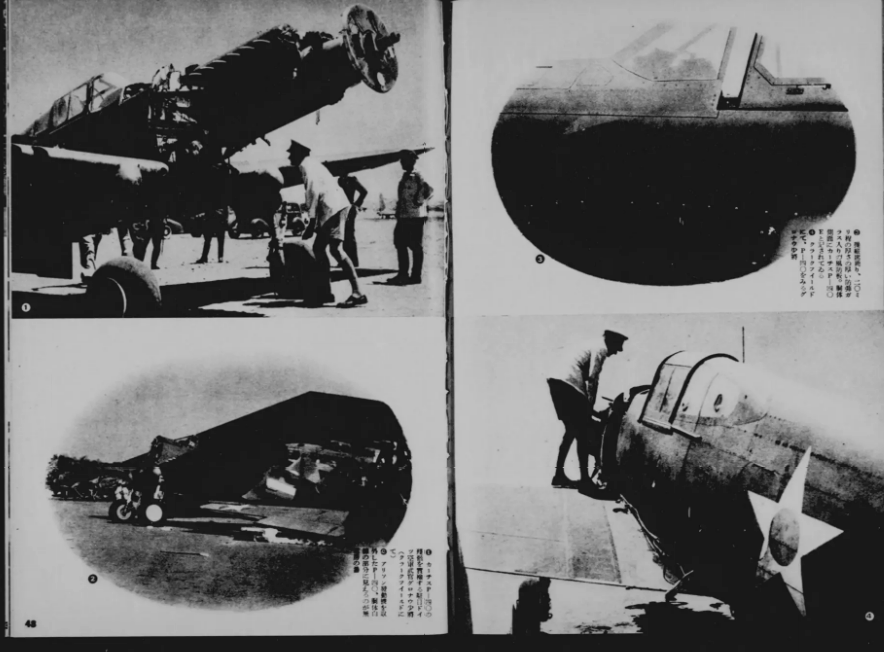- Yes
- No

Japanese Curtiss P-40E (カーチスP-40E)
The Japanese Army captured about 20 P-40E fighters from the Allies in 1942. These planes were captured in the Philippines, Java and Burma. Certainly, in 1943, three P-40E fighters served in combat in Burma in fighter unit no. 50 Hiko Sentai. However, these planes were used by the Japanese for tests and to train crews on how to deal with American fighters.
History
The Japanese captured a few more P-40E fighters in the Philippines (it is not entirely clear how many), but most of these fighters were waiting for the Japanese on Dutch Java, where the Japanese certainly captured 3 fighters ready to assemble and could acquire 27 P-40E fighters that were sunk by the Dutch, which arrived in Java not much earlier (it is not known how many the Japanese managed to recover).
The Japanese initially sent captured P-40E fighters to test facilities in Singapore and to the Japanese Koku Gijutsu Kenkyujo (Aviation Technical Research Laboratory or Gi Ken) in Tachikawa. Some P-40E planes were still in Tachikawa in 1945. In March 1943, three fighters were sent to Burma for an unknown reason, where they were to serve as night fighters to intercept enemy aircraft. They were assigned to No. 2 Hiko Chutai, No. 50 Hiko Sentai. The first information about these three fighters comes from March 11, 1943, when a mechanic who then served in Alor Star in Malaya writes about them in his memoirs. He writes in his memoirs about the appearance of a formation of three P-40s, which are airlifted to Burma, where they are to serve, so it follows that these planes were previously either in the open world or in Singapore. Further reports of these three fighters date back to March 21, 1943, when Ki-21 bombers returning from a mission over Rangoon at night were mistakenly fired at from the ground and attacked by friendly P-40 aircraft. Information about this attack can be found in Yasuhiko KUROE’s memoirs entitled “A-AH, HAYABUSA SENTOTAI” (A-ah, Hayabusa Fighter Unit) and in "Boeicho Kokan Senshi (aka “Senshi Sosho”) Vol. 61 Burma, N.E.I. Area 3rd Air Army Operations. During this attack, the Japanese lost three Ki-21 bombers and 4 crew members of these bombers were killed. Unfortunately, it is not known how long these fighters served and whether they had any other successes.

In 1943, at Haneda Airport, one of the captured P-40s was presented to the public along with other captured aircraft.

In 1943, the Japanese probably still had 10 operational P-40E aircraft, which were used to train to destroy and reconnoiter enemy fighters. However, by 1945 probably only one was still airworthy, the remaining fighters had either gone for parts or were too damaged to fly.

P-40 aircraft were also used in two films, the first being “愛機南へ飛ぶ” (Flying South) from 1943, and the second is “加藤隼戦闘隊” (Kato Hayabusa Fighter Squadron) from 1944.
A video from September 1945 showing a damaged P-40E in Japan
Construction description
The Japanese army did not modify the captured fighters in any way, which is why they are almost identical to the P-40E from the game.
General characteristics
- Crew: 1
- Length: 9,66 m ( 31 ft 8.5 in)
- Wingspan: 11.36 m (37 ft 3.5 in)
- Height: 3.25 m (10 ft 8 in)
- Wing area: 21.9 m2 (236 sq ft)
- Empty weight: 2,686 kg (5,922 lb)
- Gross weight: 3,862 kg (8,515 lb)
- Powerplant: 1 × Allison V-1710-39 V-12 liquid-cooled piston engine, 1,240 hp (920 kW)
- Propellers: 3-bladed Curtiss-Wright electric constant-speed propeller
Performance
- Maximum speed: 581 km/h (361 mph, 314 kn)
- Cruise speed: 496 km/h (308 mph, 268 kn)
- Range: 563 km
- Maximum Range: 1529 km
- Service ceiling: 8,900 m (29,100 ft)
- Climb Rate: 10,4 m/s
- Time to altitude: 4,600 m (15,000 ft) in 6 minutes 15 seconds
Armament
- Guns:
- 6 × 12.7 mm M2 Browning machine guns in the wings
- Bombs:
- 1 x 227 kg (500lb) bomb (under the fuselage)
- 2 x 45 kg (100lb) bomb (under the wings)
- Fuel dump tanks
- 1 x 196 l in additional tanks
Armour
- Same as P-40E from the game
Special thanks
Summary
The Curtiss P-40E would be a very interesting premium aircraft for Japan in War Thunder. It is a very fast and heavily armed fighter, which is incomparable to other Japanese fighters of the same Br. Of course, it has its drawbacks, such as high weight or poor maneuverability. They would be the perfect premum aircraft with an interesting history. I encourage you to discuss in the comments and to share your own knowledge on this subject.
Finally, I apologize for the linguistic and logical errors because unfortunately English is not my main language and I had to use google translator.
Internet sources
Captured P-40 (j-aircraft.com)
P-40 (航空機) - Wikipedia
Curtiss P-40 Warhawk - Wikipedia
WildEagles: Japanese P-40 by Igor Kabic (arawasi-wildeagles.blogspot.com)
Curtiss P-40E Warhawk : Curtiss (valka.cz)
During WW2, did the Japanese use captured Allied aircraft in battle? - Quora
Asisbiz Curtiss P-40E Warhawk IJAAF Army Flying School Akeno Yokota AB Japan August 1945
Japanese-Captured P-40E Warhawk | Aircraft of World War II - WW2Aircraft.net Forums
鹵獲したP-40 | ハンターカブ中心生活? (ameblo.jp)
Уголок неба ¦ Curtiss P-40D(E) Kittyhawk (airwar.ru)
P40战斗机即使被俘,也要继续抗日__凤凰网 (ifeng.com)
Looking for book on Captured Allied A/C with Japanese | Aircraft of World War II - WW2Aircraft.net Forums
Book sources
- “あぁ、はやぶさ戦隊” (A-ah, Hayabusa Fighter Unit) by Yasuhiko KUROE Kojinsha Tokyo :1969, pp 246-248
- “戦史叢書” Vol. 61 Burma, N.E.I. Area 3rd Air Army Operations, PP 284-286
- “日本軍鹵獲機秘録[新装版” (Secret record of captured aircraft in Japan) July 21, 2017
- 敵機解剖 : 大東亜戦・鹵獲・撃墜撃破飛行機写真集 - NDL Digital Collections
- 日本航空機総集 輸入機篇 (Japan Aircraft Catalogue Imported Aircraft Edition) Shuppan Kyosha, 1972, page. 174-175

Thank you for reading the suggestion, see you in the next one. Good luck pilots




























